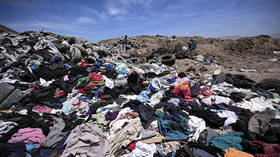Cost of EU’s African clothes dump revealed

The European Union is exporting about 90% of its used clothes and textile waste to Africa and Asia, a trend that is having a dire ecological impact, the European Environment Agency (EEA) has warned. The EEA has ranked textile waste as the fourth-highest source of environmental pressure and climate change resulting from EU consumption.
The EU generates approximately 5.8 million metric tons of textile waste per year, with only a quarter of this being recycled due to limited “reuse and recycling capacities.” The majority is shipped, in some cases as a donation, to Africa and Asia, where low-cost secondhand clothing is in high demand.
“The perception of used clothing donations as generous gifts to people in need does not fully match reality,” the EEA said in a recent report. It added that “used clothing is increasingly part of a specialized and traded global commodity value chain.”
The EEA stated the amount of used textiles exported from the EU has tripled over the last two decades, from slightly over 550,000 tonnes in 2000 to almost 1.7 million tonnes in 2019.
“Throughout the past two decades, Africa has been the main continent receiving used textiles from the EU, importing more than 60% of EU exports. While in 2000, Asia received only 26% of EU exports,” the agency said.
However, Asia’s share is said to have increased significantly in 2019, making up 41% of EU imports and nearly matching Africa, which maintained its position as the primary recipient, accounting for 46%.
Germany, Poland, and the Netherlands are said to be top exporters and “seem to have acted as import-export hubs for used textiles from the EU.”
The EEA has expressed concern about the disposal methods used in recipient countries, where garments deemed unsuitable for reuse are mostly disposed of in open landfills and informal waste streams.
Improper management of textile waste, according to the EEA, results in the emission of greenhouse gases, the depletion of non-renewable resources, and the release of microplastics into the environment.













